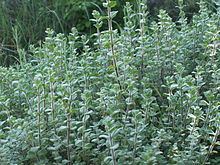Rank Species | Genus Origanum Higher classification Oreganos | |
 | ||
Similar Oreganos, Lamiaceae, Origanum onites, Micromeria fruticosa, Thymbra capitata | ||
Origanum syriacum zaatar
Origanum syriacum; syn. Majorana syriaca (also Origanum maru, although this primarily refers to a hybrid of O. syriacum), bible hyssop, Biblical-hyssop, Lebanese oregano or Syrian oregano, is an aromatic perennial herb in the mint family, Lamiaceae.
Contents
Origanum syriacum bible hyssop
Etymology
The plant may be called za'atar by association with its use in a spice mixture. In Modern Hebrew, it is called ezov, and it may have been the ezov of Classical Hebrew. In many English translations of the Bible, ezov is rendered as hyssop, hence the common name bible hyssop. However, in English, hyssop generally refers to a different plant.
Description
Origanum syriacum grows to a height of 1 meter. The plant is pollinated by bees. Flowers are small and white or pale pink.
Distribution
Origanum syriacum is native to the Middle East. In Egypt, Origanum syriacum subsp. sinaicum is a very rare plant that grows on stony ground in Sinai Peninsula including the coastal Mediterranean strip. From the conservation point of view it is an endangered plant.
Use
It is a preferred primary ingredient in the spice mixture za'atar. So precious is this herb that in the Levant, Arabs will send out foraging parties to gather it. Origanum syriacum is harvested in the wild for use in preparing za'atar, a mixture of dried herbs, sesame and sumac for flavoring and garnish. However, it has recently entered cultivation due to high levels of demand. A study of the agronomic and chemical potential of O. syriacum subsp. sinaicum showed it to be superior to O. vulgare subsp. hirtum in herb and oil yields per acre. It also identified the major constituents of the essential oil of O. syriacum subsp. sinaicum as thymol, gamma-terpinene and p-cymene, in descending order.
